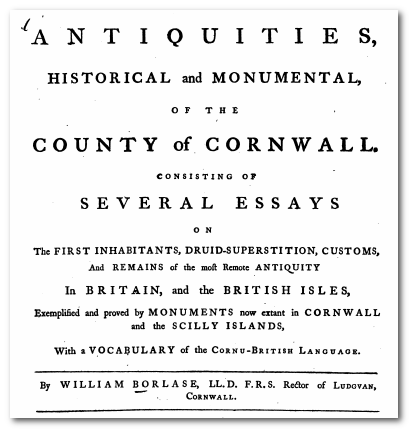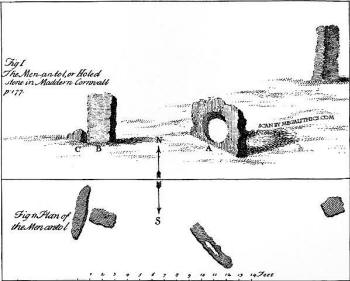|
Excerpts
from 'The Antiquities of Cornwall'
William Borlase
'Antiquities of Cornwall' was first
published in 1754, fourteen years after Stukeley's seminal work on Stonehenge. Borlase considered certain
Cornish rock-formations and neolithic earthworks to have been built by
druids. His account, which incorporated multiple references to the Old
Testament and a basic Cornish-English dictionary, remained
influential for several generations.
 It
is the usual observation of Foreigners that the English Travellers are
too little acquainted with their own Country...Gentlemen return
captivated with the Medals, Statues, Pictures and Architecture of Greece
and Italy, they have seldom any relish for the ruder products of Ancient
Britain... It
is the usual observation of Foreigners that the English Travellers are
too little acquainted with their own Country...Gentlemen return
captivated with the Medals, Statues, Pictures and Architecture of Greece
and Italy, they have seldom any relish for the ruder products of Ancient
Britain...
I must not forget to acknowledge that this branch of Antiquity is great
obliged to the labours of the learned and ingenious Dr Stukely...
It is in vain to enquire at what time this island of Britain first
receiv’d it’s inhabitants....this cannot be suppos’d to be very long
after the dispersion of mankind at Babel
Thus much then most agreeable to truth, that our first inhabitants came
from Gaul....
As we came from Gaul so we had the same language which he ancient Gauls
us’d...
Like the people of Canaan and Moab (the Druids) dyed their altars with
human gore. Groves they chose to worship in, as the Canaanites
did...performing their sacred rites only under the consecrated oak.
In order to make a proper estimate and form a right judgment of this
Idolatry of Britain, it will be necessary to give a short survey of the
rise of Idolatry in general; the false Deities that were at different
times substituted in the room of the true one.
The sacrifices of the heathens were ordain’d to consist not of sheep, or
oxen as at first but of those things which were most precious to the
heart of man, as human victims and even their own children...afterwards
their drink-offerings were the blood of their victims.
Pliny says that the Britans were so excessively devoted to all the
mysteries of magic that they might seem to have taught even the Persians
themselves that art.
It was general custom to chuse for their places of worship Woods which
stood on the tops of hills...The trees of this grove were all
consecrated by sprinkling them with the blood of human victims.
That Altar which was for offering human victims must have been very
different from what they used on less solemn occasions: there are many
flat large rocks on Karnbre-hill which probably might have been
appropriated to this horrid rite...of such holocaust Altars we have some
I think remaining still in the higher parts of the parish of Gullval...
One Druid sacrifice was still more monstrous. They made a huge image of
straw the limbs of it were joined together and shaped by wickerwork:
this sheath or case they filled with human victims...
It looks as if the Druids turned the body Sunways in their Worship, and
not from right to left as Pliny intimates.
In Cornwall we have Karn-Gollewag, that is Karn of Lights and Larn
Leskyz, Karn of Burnings both called so probably from the Druid Fires
kindled on those Karns.
Their (the woman-Druid) most solemn Rite of Divining was, by examining
accurately the entrails of their victims; an universal practice among
the Gentiles...
 Another
Relick of such Druid fancies and incantations is doubtless the custom of
sleeping on stones on a particular night in order to be cured of
lameness... Another
Relick of such Druid fancies and incantations is doubtless the custom of
sleeping on stones on a particular night in order to be cured of
lameness...
We have in Cornwall Rocks of that grandeur, remarkable shape and
surprising position, as can leave us in no doubt but that they must have
been the Deities of people addicted so much to the superstition of
worshiping Rocks. Rocks were first chose as it seems to me to represent
the Gods from the firmness of the substance...
on stone circles The Druids were extreamly addicted to Magick in
which Art the Circle was esteemed essentially necessary to carry on all
the nefarious Rites of Witchcraft, and Necromancy;
It is very unlikely if not impossible, that ever the Cromleh (Quoit)
should have been an Altar for Sacrifice, for the top of it is not easily
to be got upon, much less a fire to be kindled on it, sufficient to
consume the Victim...
I shall here describe the large flat Stone on Karn-bre with the Basons
wrought into its surface...they (the druids) made these Basons for the
purpose of collecting Rain and Snow-Water....the Druids used
Water-Purifications because these Basons could service no other use.
|

 It
is the usual observation of Foreigners that the English Travellers are
too little acquainted with their own Country...Gentlemen return
captivated with the Medals, Statues, Pictures and Architecture of Greece
and Italy, they have seldom any relish for the ruder products of Ancient
Britain...
It
is the usual observation of Foreigners that the English Travellers are
too little acquainted with their own Country...Gentlemen return
captivated with the Medals, Statues, Pictures and Architecture of Greece
and Italy, they have seldom any relish for the ruder products of Ancient
Britain...